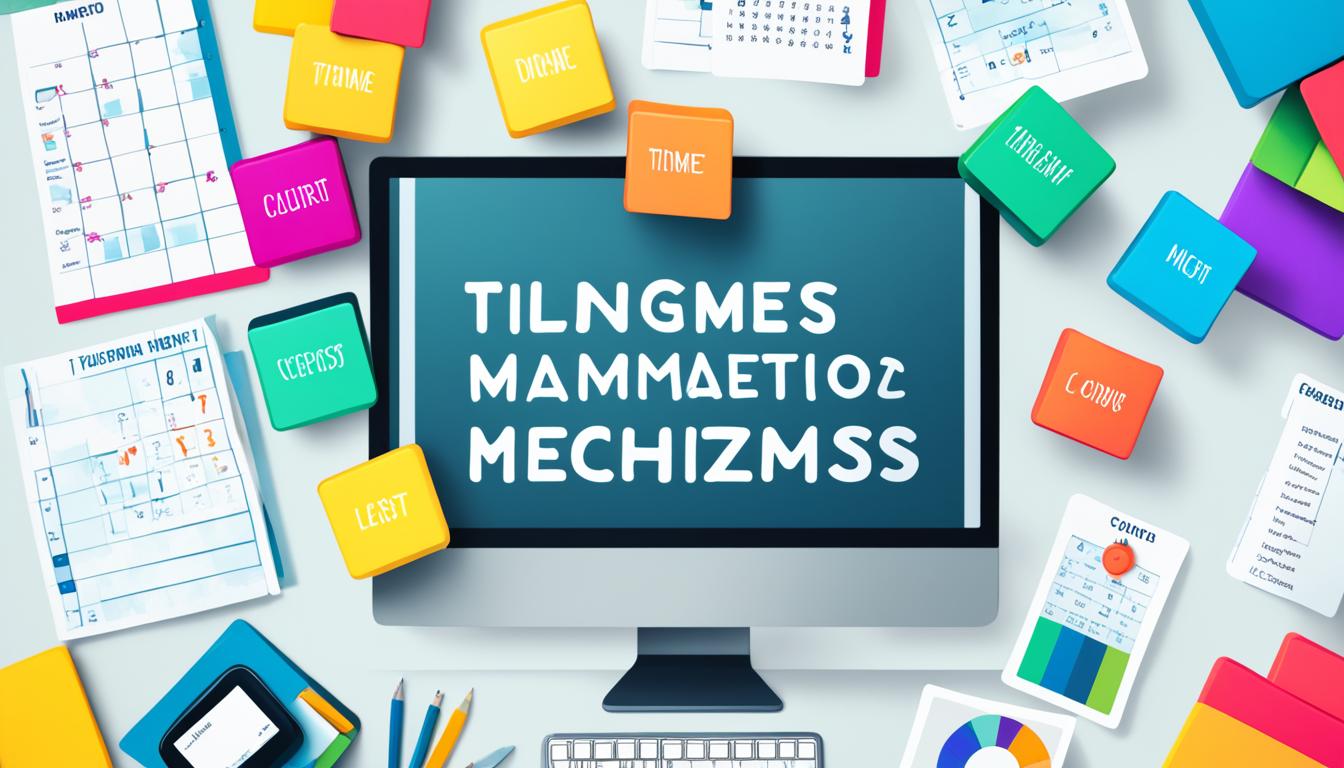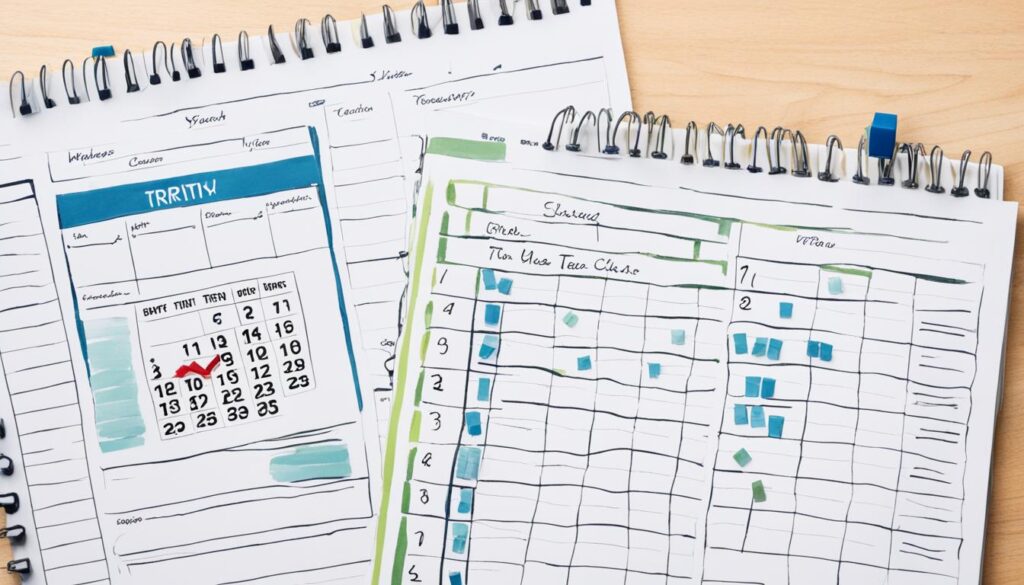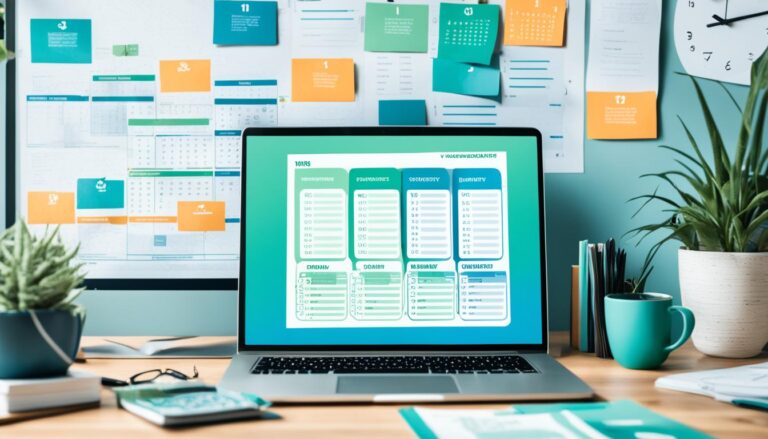Master Time Management and Prioritization Now

Are you constantly overwhelmed by the never-ending to-do lists and the feeling that there just aren’t enough hours in the day? Do you find yourself struggling to balance your work responsibilities with your personal commitments? It’s time to take control of your time and unlock your productivity potential.
In this article, we will delve into the world of effective time management and prioritization. We will explore proven strategies, techniques, and tools that can help you optimize your workflow, accomplish more in less time, and achieve success in both your professional and personal life.
From prioritization methods to time management skills, we will cover everything you need to know to become a master of your own time. So, are you ready to discover the secrets of productivity and efficient time allocation? Let’s dive in!
Key Takeaways
- Effective time management and prioritization are essential for achieving success in your work and personal life.
- There are various strategies for prioritizing tasks, including creating lists, using the MIT Method, and implementing the Eisenhower Decision Matrix.
- Time management techniques such as the Pomodoro Technique and time blocking can help you maximize your productivity and minimize distractions.
- Understanding the importance of prioritization can help you focus on what truly matters and avoid being overwhelmed by a long to-do list.
- Mastering time management skills, such as setting goals, managing distractions, and practicing self-discipline, can significantly improve your productivity.
Prioritization Strategies
Prioritization is an essential component of effective time management. By implementing the right strategies, you can optimize your productivity and accomplish your goals efficiently. In this section, we will explore several proven prioritization methods that can help you make the most of your time.
1. Lists
Creating lists can be a simple yet effective way to prioritize your tasks. Start by jotting down all the tasks you need to accomplish, then rank them in order of importance. By focusing on the top priorities first, you ensure that the most critical tasks are completed.
2. Tackling the Worst Tasks First
Often, the most challenging tasks are the ones we tend to procrastinate on. However, tackling the worst tasks first can provide a sense of accomplishment and momentum, making the rest of your to-do list feel more manageable.
3. Most Important Task Methodology (MIT)
The MIT Method involves identifying and focusing on the most significant task that will have the greatest impact on your goals. By completing this task early in the day, you set the tone for a productive day ahead.
4. Eisenhower Decision Matrix
The Eisenhower Decision Matrix helps you categorize tasks based on their urgency and importance. By prioritizing tasks into four quadrants—urgent and important, important but not urgent, urgent but not important, and neither urgent nor important—you can allocate your time and energy more effectively.
5. Ivy Lee Method
The Ivy Lee Method involves identifying the six most important tasks for the next day and prioritizing them. Start your day by focusing solely on the first task until it’s completed, then move on to the next. This method helps you maintain focus and avoid feeling overwhelmed.
6. 1-3-5 Rule
The 1-3-5 Rule involves setting one big task, three medium tasks, and five small tasks for each day. This approach ensures a balanced workload and prevents you from overcommitting to too many tasks.
7. ABCDE Method
The ABCDE Method involves categorizing tasks based on their priority level. Tasks are ranked from A (highest priority) to E (lowest priority). By focusing on completing the A tasks before moving on to the others, you ensure that your most important tasks receive your full attention.
8. Eat That Frog
The Eat That Frog strategy, inspired by Brian Tracy’s book, encourages you to tackle the most challenging task—the one you’re most likely to avoid—first thing in the morning. By overcoming the biggest hurdle early on, you boost your confidence and create momentum for the rest of the day.

| Strategy | Description |
|---|---|
| Lists | Creating and prioritizing tasks using lists |
| Tackling the Worst Tasks First | Dealing with the most challenging tasks first |
| Most Important Task Methodology (MIT) | Identifying and focusing on the most important task each day |
| Eisenhower Decision Matrix | Categorizing tasks based on urgency and importance |
| Ivy Lee Method | Identifying and prioritizing the most important tasks for the day |
| 1-3-5 Rule | Setting one big task, three medium tasks, and five small tasks for each day |
| ABCDE Method | Categorizing tasks based on priority levels |
| Eat That Frog | Tackling the most challenging task first thing in the morning |
Time Management Strategies
Effective time management is crucial for maximizing productivity and achieving your goals. In this section, we will explore various time management strategies that can help you make the most of your time. By implementing these techniques, you can optimize your workflow, minimize distractions, and accomplish more in less time.
Pomodoro Technique
The Pomodoro Technique is a time management method that uses a timer to break work into intervals, typically 25 minutes in length, separated by short breaks. This technique helps you stay focused and maintain high productivity by working in short bursts and taking regular breaks.
Time Blocking
Time blocking is a time management technique where you schedule specific blocks of time for different tasks or activities. By allocating dedicated blocks for specific tasks, you can prioritize and focus on important activities without getting overwhelmed or distracted.
Rapid Planning Method (RPM)
The Rapid Planning Method (RPM) is a goal setting and time management system created by Tony Robbins. It involves identifying your ultimate goals, breaking them down into actionable steps, and allocating time to work on those steps. This method helps you stay focused on your goals and ensures that you’re consistently making progress.
One-Minute Rule
The One-Minute Rule is a simple but effective time management strategy. The rule states that if a task takes less than one minute to complete, you should do it immediately instead of procrastinating or delaying it. By applying this rule, you can prevent small tasks from accumulating and causing unnecessary clutter or delays.
Time Tracking
Time tracking involves monitoring and recording the time you spend on different tasks and activities. By tracking your time, you can gain valuable insights into how you allocate your time and identify areas where you can improve efficiency. Using time tracking tools or apps can make this process easier and more accurate.
Getting Things Done (GTD) System
The Getting Things Done (GTD) system, developed by David Allen, is a comprehensive approach to time management and productivity. It involves capturing all your tasks, organizing them into actionable lists, prioritizing tasks based on their importance and urgency, and regularly reviewing and updating your lists. The GTD system helps you effectively manage your tasks and commitments, reducing stress and increasing productivity.

| Time Management Strategy | Description |
|---|---|
| Pomodoro Technique | A time management method that uses a timer to break work into intervals and promote focus and productivity. |
| Time Blocking | Scheduling dedicated blocks of time for specific tasks to prioritize and avoid distractions. |
| Rapid Planning Method (RPM) | A goal setting and time management system that helps you stay focused on your goals and make consistent progress. |
| One-Minute Rule | Completing tasks that take less than one minute immediately to prevent delays and clutter. |
| Time Tracking | Monitoring and recording the time spent on tasks to identify areas for improvement and increase efficiency. |
| Getting Things Done (GTD) System | A comprehensive approach to time management and productivity that involves capturing, organizing, and prioritizing tasks. |
The Importance of Prioritization in Time Management
Prioritization is a critical element in the realm of effective time management. By prioritizing tasks, you can ensure that you are devoting your time and energy to the most important and impactful activities. Without effective prioritization, you may find yourself overwhelmed by a lengthy to-do list and lacking a clear sense of direction on which tasks to tackle first.
Understanding the significance of prioritization and implementing prioritization strategies is vital for enhancing your efficiency, reducing stress, and achieving greater success in both your personal and professional life. When you prioritize, you gain the ability to focus on the tasks that truly matter, rather than getting lost in the sea of endless responsibilities.
By distinguishing between the urgent and the important, you can allocate your time wisely and ensure that you are consistently working on tasks that align with your goals and values. Prioritization helps you differentiate between tasks that have immediate deadlines and tasks that will have long-term impacts on your success.
Effective prioritization strategies empower you to make informed decisions about how to allocate your time and energy. These strategies can include techniques such as the Eisenhower Decision Matrix, where tasks are evaluated based on urgency and importance, or the Ivy Lee Method, which involves prioritizing a short list of six tasks each day.
Furthermore, prioritization enables you to optimize your workflow by identifying tasks that can be delegated or eliminated altogether. By eliminating nonessential tasks and delegating tasks that are better suited for others, you can free up more time to focus on high-priority activities that will propel you closer to your goals.
To exemplify the importance of prioritization, consider the following scenario:

| Task | Urgency | Importance |
|---|---|---|
| Respond to urgent client email | High | High |
| Attend non-essential meeting | High | Low |
| Research for upcoming project | Medium | High |
| Review and provide feedback on colleague’s report | Medium | Medium |
| Organize workspace | Low | Low |
In the provided scenario, prioritizing tasks based on both urgency and importance allows you to determine that responding to the urgent client email and researching for an upcoming project are the highest priority tasks. By prioritizing these tasks, you allocate your time and attention to activities that will have the greatest impact on your work or goals.
In conclusion, prioritization is a fundamental aspect of effective time management. By recognizing its importance and implementing prioritization strategies, you can enhance your productivity, reduce stress, and achieve exceptional results in all areas of your life.
Mastering Time Management Skills
Developing effective time management skills is essential for maximizing productivity, achieving goals, and finding balance in your daily life. In this section, we will provide you with valuable tips and techniques to help you master time management and make the most of your time.
1. Set Goals
Setting clear and achievable goals is the first step towards effective time management. Define your short-term and long-term objectives, break them down into smaller tasks, and prioritize them based on their importance and deadlines. By knowing what you want to achieve, you can create a roadmap that guides your daily activities.
2. Manage Distractions
In today’s digital age, distractions are plentiful and can significantly impact your productivity. To master time management, minimize distractions by turning off notifications on your phone, closing unnecessary tabs or applications on your computer, and creating a quiet and focused work environment. Additionally, consider using productivity tools or apps that block distracting websites or limit your time on social media.
3. Maintain a Daily Schedule
A well-planned and structured daily schedule can help you stay organized and make better use of your time. Prioritize your tasks, allocate specific time slots for each activity, and stick to your schedule as much as possible. Be mindful of your energy levels throughout the day and schedule high-priority tasks during your most productive hours.
4. Utilize Technology and Tools
Take advantage of technology and various time management tools to streamline your workflow and enhance your efficiency. Use calendar applications to schedule appointments and reminders, project management tools to track progress, and task management apps to keep yourself organized. Explore different productivity apps that align with your needs and preferences.
5. Practice Self-Discipline
Self-discipline is the foundation of effective time management. Cultivate habits that promote discipline, such as avoiding procrastination, following through on commitments, and managing your time responsibly. Stay focused on your goals and remind yourself of the importance of efficient time allocation.
6. Maintain a Proactive Mindset
Incorporate a proactive mindset into your time management approach. Anticipate potential challenges or interruptions, plan ahead, and take proactive measures to mitigate risks or address any issues that may arise. By being proactive, you can better navigate through daily tasks and unexpected circumstances, allowing you to stay on track and minimize disruptions.
By mastering these time management skills, you can optimize your productivity, reduce stress, and achieve a healthier work-life balance. Remember, effective time management is a continuous process that requires practice, self-awareness, and adaptability.

| Time Management Skills | Benefits |
|---|---|
| Setting Goals | Provides clarity and direction in your tasks and priorities |
| Managing Distractions | Increases focus and minimizes time wasted on non-essential activities |
| Maintaining a Daily Schedule | Enhances organization and ensures efficient time allocation |
| Utilizing Technology and Tools | Improves productivity by leveraging digital resources and automation |
| Practicing Self-Discipline | Fosters accountability and responsible time management behavior |
| Maintaining a Proactive Mindset | Enables effective planning, problem-solving, and adaptability |
Conclusion
Time management and prioritization are essential skills for achieving success and increasing productivity in both your personal and professional life. By implementing effective strategies and utilizing time management tools, you can optimize your workflow and accomplish more in less time.
One of the key aspects of effective time management is prioritizing tasks. By prioritizing your tasks based on their importance and urgency, you can ensure that you are focusing on the most critical activities first. This allows you to make efficient use of your time and avoid wasting it on low-value tasks.
In addition to prioritization, it is crucial to utilize time management techniques such as time blocking and efficient time allocation. Time blocking involves scheduling specific periods for different tasks or activities, allowing you to stay focused and avoid multitasking. Furthermore, utilizing tools like calendars, task management apps, and timers can help you stay organized and manage your time effectively.
Remember, effective time management requires discipline, focus, and consistent practice. By implementing these strategies and mastering time management skills, you can unlock your full potential and achieve your goals. So, start prioritizing, utilize time management tools, and take control of your time to maximize your productivity and accomplish more in your day-to-day activities.
FAQ
How can I prioritize my tasks effectively?
There are several strategies you can use to prioritize your tasks effectively, such as using lists, tackling the worst tasks first, following the Most Important Task Methodology (MIT), utilizing the Eisenhower Decision Matrix, implementing the Ivy Lee Method, applying the 1-3-5 Rule, using the ABCDE Method, and practicing the Eat That Frog strategy.
What are some time management strategies I can use?
Some time management strategies you can use include the Pomodoro Technique, time blocking, the Rapid Planning Method (RPM), the One-Minute Rule, time tracking, and the Getting Things Done (GTD) system. These strategies can help you manage your time effectively and increase your productivity.
Why is prioritization important in time management?
Prioritization is important in time management because it allows you to focus on the most important and impactful activities. Without prioritization, you may find yourself overwhelmed by a long to-do list and lack clear direction on what needs to be done first. By prioritizing tasks, you can enhance your efficiency, reduce stress, and achieve greater success.
How can I develop time management skills?
To develop time management skills, you can start by setting goals, managing distractions, maintaining a daily schedule, utilizing technology and tools, practicing self-discipline, and having a proactive mindset. These skills can help you effectively allocate your time, stay organized, and accomplish more in your day-to-day activities.
How can I achieve success and productivity with time management and prioritization?
By utilizing various strategies and techniques such as prioritizing tasks, time blocking, and utilizing efficient time allocation methods, you can optimize your workflow and accomplish more in less time. Effective time management requires discipline, focus, and consistent practice. By implementing these strategies and mastering time management skills, you can unlock your full potential and achieve your goals in both your personal and professional life.






